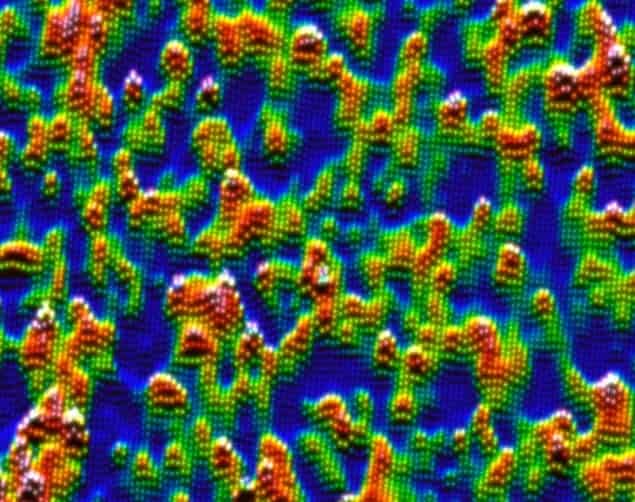
From thunderous mountain landscapes viewed from above to the erratic trajectories of Brownian motion, fractal patterns exist at many scales in nature. Physicists believe that fractals also exist in the quantum world, and now a group of researchers in the US has shown that this is indeed the case. This image shows the fractal pattern that results when the waves associated with electrons start to interfere with each other.
A fractal is a geometric entity whose basic patterns are repeated at ever decreasing sizes. For example, a river system is an approximate fractal pattern as the channels branch off into progressively narrower tributaries moving upstream; at each confluence the pattern is a smaller version of the previous branching.
A sudden transition
Ali Yazdani at Princeton University in the US and his colleagues have revealed that these patterns also exist at the scale of individual atoms in a solid. And the key to this effect is a sudden transition where a material changes from a metal to an insulator. At this transition, the waves associated with individual electrons go from being extended across the whole system to being localized at lattice sites.
We do this stuff every day, but once we managed to get the experiment to work with this material, we were confronted with what look like random patterns Ali Yazdani, Princeton University
At this metal–insulator transition the electron waves become squashed together. They begin to affect each other in a complicated network of constructive and destructive interference, which results in a fractal pattern. Yazdani and his team were able to observe this effect using a scanning tunnelling microscope (STM), which provided the atomic scale resolution.
The material used was the ferromagnetic semiconductor gallium arsenide doped with up to 5% manganese, chosen because the researchers are interested in efficient ways of turning a semiconductor into a magnet. Indeed, doping gallium arsenide in this way has become a popular approach in the burgeoning field of spintronics – electronics that exploits the spin of particles as well as their charge. Spintronics has the potential to boost the speed of computing and electronics.
Serendipitous discovery
Talking about his research, Yazdani admits that observing these fractals was not the primary aim of this research. “We do this stuff every day, but once we managed to get the experiment to work with this material, we were confronted with what look like random patterns,” he says. His group went on to develop the theory and realized that the electrons they were observing were on the brink of localization.
Yazdani and his team intend to develop their research by comparing the collective versus individual behaviour of electrons in their system and how this influences the spatial patterns. The bigger picture of this research is to connect these patterns with theories of magnetism to advance both fundamental research and the development of spintronics applications.
This research is published in Science.



